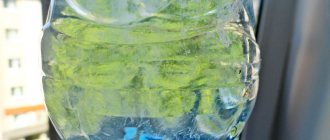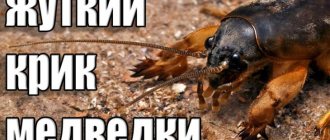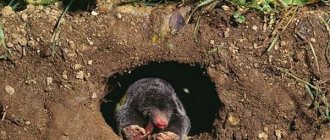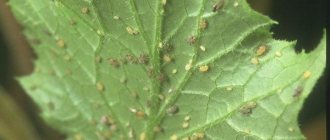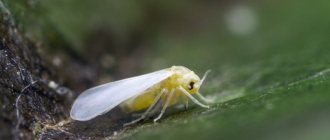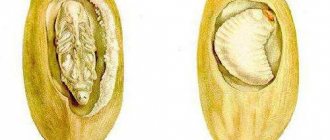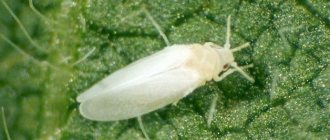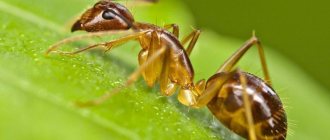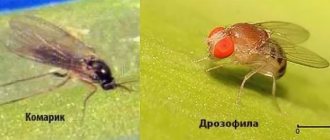Growing cucumbers is a troublesome business. The culture is very demanding in terms of temperature and humidity, and is often attacked by insects. Midges on cucumbers are the most common pests that can cause significant damage to the plant and thereby reduce productivity. Midges mean a variety of small flying insects, and methods of combating each species are different.
What kind of pest is this
Whitefly, or white midge, is a dangerous pest . The insect feeds on plant sap and reproduces very quickly. The whitefly and its larvae usually settle on the lower surface of the leaf.
Often the insect appears in greenhouses, as it loves a warm and humid climate. Lives on plants in groups.
Appearance
Whiteflies (pictured) are small moth-like insects with milky white wings and a white or yellow body. They reach no more than 3 mm in length. They have 4 wings, covered with a white coating reminiscent of flour.
Whitefly larvae are small, up to 0.3 mm in size. They look like translucent yellow scales. Having hatched from the egg, they attach themselves to the leaf and begin to actively feed on its juice.
Later comes the pupal stage. At this time, the larva is maximally resistant to various drugs. Then an adult with wings emerges from the pupa, which is capable of flying to other plants and reproducing.
Symptoms of cucumber damage
Due to the fact that whiteflies live on the underside of leaves, they may not be noticed immediately. It is necessary to systematically inspect cucumbers and know the signs by which whitefly infestation is determined:
- the surface of the stems and leaves becomes sticky and covered with a white coating;
- the leaves curl, fade, wither;
- yellow or green spots with blurred boundaries appear on the leaves;
- larvae are visible on the inside of the leaf;
- over time, a black coating appears - sooty fungus (such an infected plant is dug up and burned);
- The development of the vegetable slows down noticeably and the yield decreases;
- if you shake cucumbers, a swarm of white midges rises into the air - these are whiteflies.
If at least one of the listed signs is detected, it is necessary to urgently take measures to combat the pest.
Mining flies
Leaf miners are also often called midges. The insects got their name from their feeding habits. The length of adult individuals does not exceed 2 mm. The color is variable and depends on the species. The female pierces the foliage with her ovipositor and lays eggs. After a few days, larvae emerge from them and gnaw through white passages called mines. After the food resource is exhausted, the young individual moves to the next leaf.
The female lives about 7 days. During this time, she manages to lay up to 400 eggs.
Insect activity begins in May and June. In case of serious infestations, plant growth deteriorates and leaves die off. How to deal with leafminer on cucumbers:
- colorful sticky traps are used to prevent the invasion of dangerous parasites;
- damaged leaves must be removed;
- surviving plants are treated twice with insecticides; Before flowering, you can apply Aktar, during the fruiting period - Vertimek.
Only regular inspection of seedlings, timely care and identification of pests will help preserve the cucumber crop.
Damage caused
Since the insect feeds on plant juices, affected cucumbers begin to lag behind healthy ones in development . Their leaves dry out and fall off over time, and subsequently the entire crop withers.
Due to lack of fluid, the ovaries cannot fill and fully ripen. This leads to a sharp decrease in yield.
The white midge carries diseases such as jaundice, yellow mosaic, chlorosis, leaf curl and fruit necrosis. In places where the whitefly drank the juice and left its excess, chlorophyll is not formed and various pathogenic microorganisms develop.
Parasite recognition
If midges appear on the stems, this is the very first sign of the development of the disease. The small butterfly is called a whitefly. It is characterized by one feature - gathering in small groups under the leaves. Midge larvae concentrate in the same place. Every day there are more and more parasites on cucumbers.
In parallel with the disease, chlorosis develops. It is a mosaic lesion of yellow leaves. Sooty fungus is often observed. Black spots indicate its presence. The leaves of cucumbers, which are parasitized by the midge pest, gradually turn yellow and wither, and the ovaries fall off.
In order to timely identify the whitefly and begin to fight it, you need to carefully monitor the seedlings. Butterflies tend to reproduce quickly. Thus, midges move to other plants. A farmer could lose his entire crop because of a small insect.
How to deal with whitefly on cucumbers in a greenhouse
As soon as you notice the first signs of pests appearing in the greenhouse, immediately take measures to destroy them . First, try mechanical methods of removing whiteflies from a bush:
- Collect the insect by hand with a sponge dipped in soapy water.
- Remove and burn the leaves on which the larvae have settled. It makes sense to remove leaves if the plant is slightly damaged. If the whitefly has occupied more than 40% of the cucumbers, this method will not work.
- Wash off the insects from the bush with strong water pressure from a hose, and then treat the leaves with a soapy solution.
- Collect adult insects with a hand-held vacuum cleaner.
These are only temporary measures that are not able to completely destroy insects, but can significantly reduce their number before further control.
There are various ways to combat whiteflies: mechanical traps, traditional methods, biological agents and chemicals.
It is better to get rid of insects using chemicals at the last moment, if other tried means have not given the desired result.
Mechanical traps
Traps for whiteflies can be bought in specialized stores or made with your own hands:
- Paint a plastic bottle orange, cover the outside with a layer of sticky glue or a mixture of Vaseline and laundry soap (1:1). Light it from the inside and hang it in the greenhouse at the growth level of the cucumber bushes. The midges will fly to the light and stick to the surface of the trap.
- Place a light bulb with a red or orange light in a small wooden box (or paint a regular light bulb). Hang the structure in the greenhouse and place a container of water under it. Whiteflies will fly into the light, get burned by the light bulb and fall into the water.
Reference . Such traps are capable of exterminating up to 80% of adult pests in a greenhouse.
Traditional methods
Gardeners who encounter whiteflies on cucumbers are always interested in how to treat the plants against the pest without resorting to chemicals. For such purposes, there are folk recipes against white midges:
- Soap solution . To spray and wipe the leaves, use laundry or tar soap. It is mixed with water in a ratio of 6:1.
- Sugar solution. 100 g of sugar is dissolved in 400 ml of water. The mixture is treated with infected leaves. If the remedy does not help the first time, repeat the procedure after a week. 5 days after treatment, thoroughly wash the leaves to remove the sugar film.
- Lemon infusion . 100 g of lemon peels are poured into 1 liter of water for 24 hours. Add 60 g of soap. After this, the infected leaves are sprayed with a solution from a spray bottle.
- Garlic infusion . Finely chop 300 g of garlic cloves and fill them with 1 liter of water. Leave in a dark place for 5 days. Then 5 g of the resulting solution is again diluted in 1 liter of clean water. Spraying is done using a spray bottle.
- Dandelion infusion . 80 g of dandelion leaves and roots are poured into 1 liter of water and left for about 4 hours. After this, the solution is filtered and the infected leaves are sprayed with it.
- Infusion of yarrow. Add 100 g of yarrow herb to 1 liter of water and leave for 2 days in a dark place. Then the infusion is filtered and the cucumber beds are treated with it.
HOW TO FIGHT WHITEFLY, WITHOUT CHEMICALS!!!!!!! IN A GREENHOUSE, WITH AVAILABLE MEANS, A SIMPLE METHOD
Biological agents
An interesting biological way to exterminate whiteflies is to include other insects in the fight against it. In nature, white midges and their larvae are hunted by, for example, ladybugs and lacewings. To attract them, marigolds are planted next to cucumbers.
There is also an insect in nature that parasitizes whitefly larvae. This is an encarzia - an ichneumon rider from the order Hymenoptera. She lays her eggs directly into the white midge larvae, thereby destroying them. Insects are populated in the greenhouse at the rate of 20 individuals per 1 m2.
Important ! Villi on the leaves of cucumbers prevent encarsia from reaching the whitefly larvae, so this method may not work to its full potential on this particular crop.
The biological preparation "Verticillin" contains a fungus that can kill both larvae and adult whiteflies. At the same time, it does not cause any harm to plants, animals and humans. The drug “Fitoverm” will also help in the fight against pests.
Chemicals
If the previous methods did not help or the whitefly infestation has reached significant proportions, you will have to resort to chemical means.
The most effective insecticides against whiteflies include:
- " Aktellik ". Sold in ampoules. The contents of one ampoule (2 ml) are dissolved in 2 liters of water and sprayed. Up to 2 treatments are allowed. Protective effect in a greenhouse is 10–12 days.
- " Arrivo ". Consumption rate: 1.5 ml per 10 liters of water. Protective effect - 10–14 days.
- "Bona Forte " (insecticide). The contents of the ampoule (2 ml) are dissolved in 0.5 l of water. Valid for 2-3 weeks.
- "Inta-Vir" . 1 tablet per 10 liters of water. Up to 3 treatments.
- " Spark ". First, ½ tablet is completely dissolved in a small amount of water, then diluted with water to 5 liters. Repeated spraying is possible after 20 days.
- " Confidor ". 1 ml per 5–10 liters of water. Protective effect - 15–30 days.
- " Talstar ". 0.6 ml per 1 liter of water. Protects the culture for 2-3 weeks.
- " Tanrek ". 5 ml per 10 liters of water. Pour 1 liter of liquid into a plastic bucket, add 5 ml of the drug, mix, dilute to 10 liters. The effect lasts up to 4 weeks.
- " Fas " (insecticide). ½ tablet per 5 liters of water. The interval between treatments is 15–20 days.
- " Fufanon ". 13 ml per 10 liters of water. Protective effect – 5–10 days.
You can eat fruits after treating cucumbers with chemicals only after a month. In the case of biological products - after 2-3 days. Diluted chemicals cannot be stored.
Important ! When handling chemicals, wear a respirator. Make sure that the drug does not come into contact with exposed skin. It is better to throw away gloves after use. Wash your hands, face and eyes with soap.
Most insecticides repel all insects, including bees, so cucumbers should not be treated with them during the flowering period.
What types of midges are there?
First, let's figure out what kind of pests these are. And in order to make it easier for you to identify the insects that attacked your favorite flower, we suggest conditionally classifying them according to a very simple and striking feature - color. Most often, black or white midges are found on indoor plants.
White midges
These are usually whiteflies. There are quite a few types of whiteflies, but houseplants are most often attacked by b. tobacco, b. greenhouse and b. citrus. They look like snow-white or slightly yellowish tiny moths. The adults (adults) do not cause harm, but the larvae cause great damage by gnawing the lower part of the leaf.
Whiteflies on a citrus plant leaf
In addition to the cloud of insects that appears when you touch the pot or the plant itself, honeydew can be seen on the underside of the leaf blade. These are sticky, sugary white specks that are waste products of whiteflies. If you do not get rid of the pest in time, then a sooty fungus will begin to develop on the leaves - a faithful “comrade” of honeydew.
In addition to whiteflies, you may notice so-called soil midges. They do not fly, but they jump very actively. These are springtails. There are many varieties of them in nature, but most often found in indoor plants are six-legged ones of white or cream color. Otherwise, they are often called fools, but from a scientific point of view this is not entirely true, since real fools live in puddles, swamps and ponds, feeding on mosses, lichens and simple fungi. “Our” pest is the closest relative of the fool. It looks like a tiny (about 2 mm in length) caterpillar with a short mustache.
springtail
In a normal agricultural regime, a certain amount of springtails is always present in the soil of a houseplant, but they behave unnoticed and do not cause harm. With a “successful” combination of circumstances, they can simply multiply in a flurry, and then something will have to be done about it.
Black midges
Small black midges on house flowers are called sciarids, otherwise known as fungus gnats. Their length varies from 0.5 to 3 mm. Just like whiteflies, the adults of these insects do not harm plants or people, but their larvae make their way into the ground and feed on organic debris and fungi growing on them, thereby compacting the soil. When mass reproduction occurs, pests begin to use plant roots as food. As a result, infected green pets develop poorly and have a wilted appearance. The most common reason for the proliferation of black midges is fertilizing potted plants with damp, sleepy tea leaves, banana peels and similar organic waste.
Sciarida close up
The sciarid should not be confused with another midge that is very common in the summer-autumn period - the Drosophila. Otherwise, it is also called the fruit midge, since it needs the rotting pulp of fruits or vegetables to feed. If you remove all such products from free access, there will soon be no more fruit flies. By the way, these insects do not harm either plants or people, so the discomfort from their presence is only psychological.
Drosophila needs fruit
Features of wrestling in open ground
In open ground, whitefly infection most often occurs through seedlings. Before planting, carefully inspect the seedlings for insects or signs of their presence.
To prevent infection of cucumbers in the garden or plot, the “Bud” product is suitable. Dilute 10 g of the drug in 10 liters of water and spray vegetables every 10 days.
If you find whiteflies on cucumbers in open ground, first wash them off with water and loosen the top 2 cm of soil. Then treat the plant several times with a soap solution and insecticide. Iskra is well suited for these purposes.
Spraying should be carried out in dry, windless weather, in the morning (before 10:00) or evening (after 18:00), when the plants are not at risk of sunburn.
Spider mite
Spider mites mainly grow in greenhouses and greenhouses, but are also found on cucumbers in open ground
If cobwebs appear on your plants, pay close attention; most likely it is a mite.
The insect lives under a leaf, in the shade, although it loves the heat. The tick has a red color with a green tint. One female spider mite lays about 150 eggs per season, and if you do not fight this insect, the plant will die, because. these pests will suck all the juices from the leaves and flowers, drying out the sprouts.
To prevent spider mites, plant dill, parsley or carrots in the same bed with cucumbers. Ladybugs love to live on the plants listed above and they feed on mites. Also, the mite does not like moisture, and abundant watering for cucumbers only brings benefits.
If spider mites have already infested your cucumber beds, the plants can be treated with compounds that are harmless to humans and lethal to pests:
Treatment of cucumbers with chemical compounds is possible only in the early stages of plant growth; the rest of the time, such spraying is simply dangerous because the poisons will not have time to get out of the fruits.
Preventive measures
To prevent the appearance of whiteflies on cucumbers in a greenhouse, a number of rules should be followed:
- Use traps. A bright surface will attract insects, and a sticky surface will prevent them from escaping.
- Experienced gardeners recommend using the “Bud” product for prevention.
- Carefully inspect the seedlings before planting in the ground. Purchase seedlings only from trusted manufacturers. Check the leaves before purchasing.
- After harvesting, carefully dig up the soil and remove all plant debris and debris.
- Treat the soil with bleach or copper sulfate. Fumigate the greenhouse with tobacco smoke. Treat the frames with Bordeaux mixture.
- Freeze the greenhouse in winter: open it for 1-2 days when the temperature drops below -12...-15 °C. In such conditions, insects die.
- Do not plant plants very densely and avoid extreme heat and humidity in the greenhouse. You can stretch a gauze mesh over the windows in the greenhouse.
Don’t be lazy to carry out prevention, and then the whitefly will not be scary for your cucumbers.
Forget about whiteflies in your area! An easy solution to your whitefly problem.
Slugs
During rainy, cloudy periods or in shaded, damp places under the cucumber vine, slugs breed en masse. These slow and, at first glance, completely defenseless creatures with great appetite eat the greens of cucumbers and eat the pulp of their fruits.
Night pest
They lay eggs in the soil on the eve of winter. In the spring, young individuals hatch from them, and after a couple of months they begin to eat the plants. Moreover, they do this only at night, and when the first rays of sunlight appear, they hide in secluded damp places until the evening. These mollusks feel especially good in a greenhouse, where high humidity is constantly maintained and there is no direct sunlight.
Control measures:
- Slugs are removed mainly by hand. Since they come out of hiding only in the dark, it is best to destroy them in the evening. You can walk around at night with a flashlight and collect the specimens you come across, or you can make your task a little easier and create a special shelter-trap where they will hide from the sun, and then simply collect them.
- Spray the plants with an aqueous infusion of hot capsicum. This liquid will not harm cucumbers, but slugs will not like it at all.
- An effective method is to treat the soil with slaked lime, ash, copper sulfate, and aqueous infusion of ammonia.
- It is necessary to monitor the bed, dig up the soil and regularly remove plant debris.
- We advise supporters of chemical drugs to use a product against slugs such as “Meta”.
Reviews
All these methods have been repeatedly tested by gardeners who have at least once fought against whiteflies. Not every method bears fruit, and sometimes new solutions appear that unexpectedly lead to victory.
Galina, Kazan: “What if you use a sulfur bomb to treat a greenhouse? Every autumn I light 3 checkers at the same time (I have a large greenhouse). And in the summer I make tobacco smoke in the greenhouse - it doesn’t harm the plants, but the effect is excellent! There are no whiteflies..."
Tatyana, Voronezh region: “ Last year I was in a greenhouse in the summer, but I couldn’t destroy it. In winter I kept the greenhouse without snow; I added snow only in February. I didn’t see it in the greenhouse this summer. So it’s not all that bad.”
Natalya, Perm: “I only had whiteflies in the first year of my gardening. Then I started hanging up bottles of iodine - there were no pests or late blight.”
Margarita, Tyumen: “ I’m militantly determined for the summer of 2022!” I've been on the warpath since the fall! First of all, I treated the diseased (and not only) bushes behind closed doors. The next day I dug up all the bushes, took them far beyond the site and burned them! I dug up the ridges when it got cold and didn’t cover them with snow. I wanted to freeze this disgusting thing, but it’s not for nothing that they say - be afraid of your wishes! The winter turned out to be fierce: 10–15 centimeters of snow fell during the entire winter, and the frost was -50! Not only the whitefly froze - 90% of the perennial flowers, almost all the vegetables in the cellar. So I won this war at the cost of great losses, but there were no whiteflies in my greenhouse in the summer of 2022!”
Yuri, Chelyabinsk: “I struggled for six months, all to no avail, nothing helps. The fumigator (Transflutrin liquid) unexpectedly helped. All those flying died within a day. It does not affect larvae and eggs, you need to wait until the butterflies hatch. We close the greenhouse tightly, turn on the fumigator in the evening (at night), turn it off in the morning, repeat every other day, and so on for a month (preferably two). The effect is 100%.”
Why do cucumbers rot?
Growing cucumbers indoors is not an easy task; you have to constantly maintain a certain microclimate, control the composition and condition of the soil, limit the growth of vines, and carry out preventive treatments. Only if you carry out a set of agrotechnical measures can you count on a bountiful harvest. In open beds everything is a little simpler.
Attention! Cucumbers bred specifically for growing in greenhouses and hotbeds can also rot if you miss some detail, for example, systematically watering them with cold water.
In open ground, it is possible to avoid rotting of cucumbers even in unfavorable weather, but only if you change the place for the crop and choose the right predecessors (onions, cruciferous crops, legumes and nightshade crops). Greenhouse conditions greatly complicate crop rotation. An annual, complete replacement of the fertile soil layer, in which fungal spores and larvae of harmful insects accumulate, is required. The main reasons for the development of rot:
- temperature violation;
- improper watering;
- unregulated air humidity;
- excessive or insufficient nutrition;
- lack of ventilation;
- cold drafts;
- crowdedness;
- ignoring disinfection.
The infection can be introduced into a greenhouse or garden beds on shoes and gardening tools; the source of infection is the soil in which the seedlings grew, as well as seeds. The spores are carried by aphids and whiteflies. Problems arise with neglected plants or due to improper harvesting. Old canes, overgrown greens and yellowed leaves are removed. Cucumbers are grown only on a trellis or twine, without allowing the ovaries to come into contact with the soil. Cucumbers are cut or torn off carefully, without leaving mechanical damage and always together with part of the stalk.
Prevention
It is better to prevent the development of pests, then look for effective methods of combating them. Thanks to simple preventive measures, you can protect cucumbers from aphids. But how to get rid of this pest from your area forever, and what products should be used is indicated here.
The following recommendations should be followed:
- It is necessary to systematically loosen the soil, eliminating weeds. It is because of the weeds that aphids arise and move to vegetable crops.
- Attract ladybugs to the garden, for which aphids are excellent food. To do this, plant leaf mustard near the cucumbers. Ladybug is a natural helper against aphids.
- Eliminate ant colonies using chemical insecticides or folk remedies.
- Avoid planting cucumbers too thickly.
- Water the cucumbers 2 times per season with a solution of laundry soap.
The video shows ways to prevent and control black aphids:
Black aphids are an insidious pest that causes great damage to the yield of various vegetable crops, including cucumbers. To combat insects, you can use both chemical and folk remedies. Each of them is effective in its own way. When choosing them, you need to focus on the number of insects. If there is a massive lesion, then home remedies will not cope with it. Find out how to get rid of aphids on raspberries here.
Signs of infection of cucumber bushes
In order not to miss the moment of parasite infestation, you need to regularly inspect cucumber bushes growing in the greenhouse and outside. The first sign of a problem will be the presence of small gray insects. These are midge larvae that usually collect on the underside of leaves.
Adults are small white butterflies. If there are only a few of them yet, you can try to collect insects by hand. The butterflies lay a large number of transparent eggs, from which new midges hatch in just a few days. As they grow, they feed more and more intensively, drawing out the last strength from the vegetable crop. And then they stop eating, having reached the pupal stage. Carefully inspect the leaves. First, white dots and spots appear on them. Gradually the tops turn yellow and finally wither.
